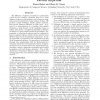Free Online Productivity Tools
i2Speak
i2Symbol
i2OCR
iTex2Img
iWeb2Print
iWeb2Shot
i2Type
iPdf2Split
iPdf2Merge
i2Bopomofo
i2Arabic
i2Style
i2Image
i2PDF
iLatex2Rtf
Sci2ools
CVPR
1996
IEEE
1996
IEEE
Pattern Rejection
The e ciency of pattern recognition is particularly crucial in two scenarios; whenever there are a large number of classes to discriminate, and, whenever recognition must be performed a large number of times. We propose a single technique, namely, pattern rejection, that greatly enhances e ciency in both cases. A rejector is a generalization of a classi er, that quickly eliminates a large fraction of the candidate classes or inputs. This allows a recognition algorithm to dedicate its e orts to a much smaller number of possibilities. Importantly, a collection of rejectors may be combined to form a composite rejector, which is shown to be far more e ective than any of its individual components. A simple algorithm is proposed for the construction of each of the component rejectors. Its generality is established through close relationships with the Karhunen-Lo
eve expansion and Fisher's discriminant analysis. Composite rejectors were constructed for two representative applications, n...
| Added | 07 Aug 2010 |
| Updated | 07 Aug 2010 |
| Type | Conference |
| Year | 1996 |
| Where | CVPR |
| Authors | Simon Baker, Shree K. Nayar |
Comments (0)

